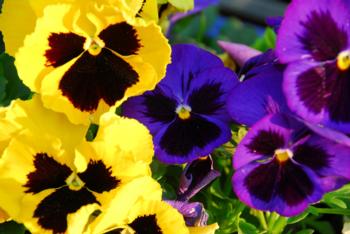Unused stories
Gardening Tips - Fall Gardening Tips

OCTOBER
• Compost disease-free annuals and vegetable crops that have finished producing.
• Clean up diseased and damaged plant materials so the pathogens don’t overwinter. Remove dead roots, leaves and stems from your vegetable garden and pick up fallen fruit. Dispose of them in your green can.
• Add compost and soil amendments to your garden; cultivate into soil, but don’t disturb shallow-rooted plants.
• Plant cover crops, like fava beans, crimson clover and vetch, to improve soil structure and fertility in bare vegetable beds.
• Feed azaleas, camellias and rhododendrons with a 0-10-10 fertilizer monthly up to bloom time.
• Visit nurseries to see trees and shrubs with outstanding fall color; determine if there’s a place in your garden that would benefit from one of these selections.
• Plant ornamental grasses, shrubs, perennials, evergreens and groundcovers. Winter rains will help establish sturdy root systems.
• Buy bedding plants for fall and winter color, including calendulas, cyclamen, Iceland poppies, nemesia, osteopermum, pansies, primroses, snapdragons and violas.
• Plant nursery starts of cool-season vegetables. In foggier microclimates: artichoke (rootstock), fava beans, cabbage, garlic, leeks, peas, spinach, Swiss chard, lettuce, radish (small varieties), shallot sets. In sunnier microclimates: artichoke (rootstock), fava beans, cabbage, cauliflower, Chinese cabbage, garlic sets, leeks, peas, radish (small varieties), spinach, Swiss chard.
• Reseed bare spots in your lawn or install sod. Consider reducing the size of your lawn or removing it entirely to conserve water.
• Dig up corms and tubers of gladiolus, dahlias and tuberous begonias after the foliage dies, if you’ve lost these plants over past winters. Store them in a cool, dry place.
• Put tulip, narcissus and hyacinth bulbs in the refrigerator in breathable bags to pre-chill for six weeks prior to planting. Do not store them with apples, which emit ethylene gas that will sprout the bulbs.
• Start amaryllis, narcissus and paperwhite narcissus bulbs inside for holiday gifts.
• Visit your garden after dark with a flashlight and handpick snails and slugs. Control measures in fall will help reduce populations in spring.
• Reduce your irrigation times significantly as day length shortens and plant growth slows or stops.
• Prepare planting holes now for installing bare-root plants and trees in winter.
NOVEMBER
• Sow native wildflower seed.
• Plant perennials and evergreens.
• Dig, divide and replant overgrown perennials for more profuse blooms next spring.
• Mulch bare soil to hold in moisture, keep out weeds and prevent compaction by hard rains.
• Plant bulbs for spring color, including daffodils, crocus, freesia and hyacinths.
• Plant garlic and shallot sets.
• Prune dead or broken branches on trees and shrubs.
• Remove the bands of corrugated cardboard used to trap codling moth larvae from around apple tree trunks and dispose of them.
• For larger camellia blooms, remove all but one fat bud from each stem.
• Compost fallen leaves. Layer green and brown materials in your compost pile.
• Create new planting areas by layering sheet mulch (click here for a how-to video) over weed patches or unwanted lawn.
• Turn off your irrigation system for the season; continue to water plants under overhangs.
DECEMBER
• Plant any bulbs you’ve pre-chilled as soon as you’ve removed them from the refrigerator.
• Cover open compost bins with a tarp when the rains begin.
• If frost is predicted, cover sensitive garden plants such as citrus, fuchsia and succulents or move them under a sheltering overhang. Use stakes around the plants to suspend the covering material so it doesn’t touch the foliage.
• Clean your tools—remove all soil and wash them with a 10 percent bleach solution to avoid spreading diseases. After drying them completely, apply a light layer of vegetable oil to prevent rusting.
• Sharpen your tools.
• Take cuttings of succulents and create small container gardens for holiday gifts.
• Bring trimmed bare branches indoors for a unique decorative element.
• Tour your landscape during a heavy rainfall. See where water is coming off your house and where there are eroding torrents. Think about ways to slow, spread and sink the rain.
